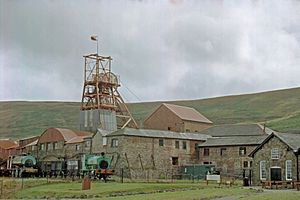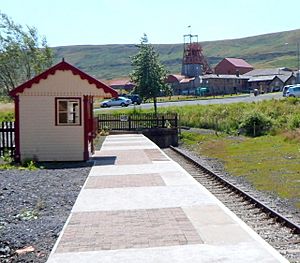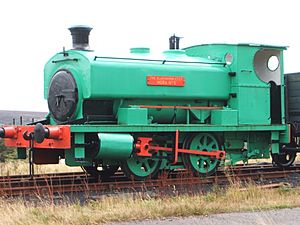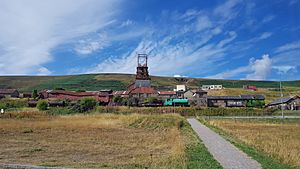Big Pit National Coal Museum facts for kids
| Pwll Mawr Amgueddfa Lofaol Cymru | |

View of museum with the winding tower.
|
|
| Established | 1983 |
|---|---|
| Location | Blaenavon, Wales |
| Visitors | 129,396 (Fiscal year 2019) |
| UNESCO World Heritage Site | |
| Part of | Blaenavon Industrial Landscape |
| Criteria | Cultural: (iii), (iv) |
Big Pit National Coal Museum (in Welsh: Pwll Mawr Amgueddfa Lofaol Cymru) is a special museum in Blaenavon, Wales. It teaches people about the history of coal mining. This place was a real working coal mine from 1880 until 1980.
In 1983, Big Pit opened its doors to the public as a museum. It became part of the National Museums and Galleries of Wales in 2001. The museum helps us remember the important role of coal mining in Welsh history. This was especially true during the Industrial Revolution.
Big Pit is next to the Pontypool and Blaenavon Railway. It is also part of the Blaenavon Industrial Landscape. This area is a World Heritage Site, recognized by UNESCO. It is also an important spot on the European Route of Industrial Heritage.
Contents
Discovering Big Pit's Mining Past
Big Pit started as an iron mine around 1810. Miners dug into the side of the mountain to find iron. This old part is called Engine Pit Level. It can still be seen today.
Big Pit was part of a larger group of coal mines in Blaenavon. These mines were set up in the early 1800s. They helped the Blaenavon Ironworks grow. Big Pit became the most important mine in the area.
Historians are not sure exactly when Big Pit started working regularly. It might have been an older mine called Kearsley's Pit. This pit was mentioned in company records from the 1860s.
How Big Pit Became a Big Mine
In 1881, a report first described the mine as "Big Pit." It was called this because of its large, oval shape. It was 18 feet by 13 feet wide. This made it the first mine shaft in Wales big enough for two tracks for coal carts. Once it was finished, it was used to bring coal up. An older shaft, Coity Pit, was used to let fresh air into the mine.
By 1908, Big Pit employed 1,122 people. At its busiest in 1923, about 1,400 men worked there. They dug up house coal, steam coal, ironstone, and fireclay. The mine produced over 250,000 tons of coal each year. Coal from Big Pit was sent all over the world.
Before 1908, miners did everything by hand. This included cutting the coal. Big Pit was one of the first mines to use electricity. By 1910, electric power ran fans, hauling systems, and pumps.
Improving Miners' Lives
In 1939, special baths were built at the mine. This meant miners did not have to walk home dirty and wet. This helped them stay healthier. The baths also helped their families. Women no longer had to carry hot water for baths at home.
During World War II, coal was also dug from the surface at Blaenavon. In 1947, the National Coal Board took over the mine. This was when coal mines across the country became owned by the government. At that time, 789 men worked at Big Pit.
By 1970, fewer people worked at the mine. Operations focused on a thinner coal seam. Big Pit stopped bringing coal up its main shaft by 1973. Coal was then moved through a new tunnel. The mine finally closed on February 2, 1980. This meant over 250 people lost their jobs.
Moving Coal by Rail
In 1866, the Brynmawr and Blaenavon Railway opened. This railway had tracks that went right to the mine. It allowed coal to be sent to other parts of the country. Later, the line extended south to the coast at Newport. From there, coal could be shipped overseas.
Passenger trains stopped running on this line in 1941. After other mines closed, the northern part of the line was shut down. However, the line was later extended again in the 1970s. This helped move coal from new mining areas.
Today, the Big Pit Halt railway station is next to the museum. It opened in 2011 for tourists. This allows visitors to arrive by heritage train.
Safety and Accidents in the Mine
Mining was a very dangerous job. Between 1857 and 1880, over 60 deaths were reported in the Blaenavon coal and ironworks. From 1880 onwards, there were regular reports of accidents at Big Pit. Many of these accidents resulted in miners losing their lives.
For example, in 1891, a boy named Thomas Oliver Jones died in a roof fall. In 1908, three men were killed in an explosion. Another three men died in a fire in 1913. These events remind us of the risks miners faced every day.
Big Pit as a Tourist Attraction Today
Before the mine closed, people thought it could become a heritage site. After it closed, the local council bought the site for £1. A charity called the Big Pit (Blaenavon) Trust then managed its change into a museum. The museum opened to visitors in 1983.
On February 1, 2001, the museum became part of the National Museum Wales. It was first called the "National Mining Museum of Wales." Now, it is known as "Big Pit: National Coal Museum."
How Many People Visit Big Pit?
When the museum first opened, fewer visitors came than expected. In 1983, less than 100,000 people visited. Numbers reached a high of 120,000 in 1992. But then, visitor numbers went down.
In 2000, the museum received a large grant of over £5 million. This money helped improve the visitor facilities. After becoming part of the National Museum Wales, visitor numbers grew a lot. Over 140,000 people visited in 2014/15. In 2017, there were 150,176 visitors.
Awards and Recognition
In 2000, the Blaenavon industrial area, including Big Pit, became a World Heritage Site. This was decided by UNESCO. It recognized the area's importance to the Industrial Revolution. In 2005, the museum won the Gulbenkian Prize. This award is now called Museum of the Year.
Exploring the Museum Safely
Big Pit is kept as a working attraction. This means many parts are still like they were when the mine was active. The wooden props and steel bands in the mine are real. They still hold up the mine roof. The water flowing underground is also real.
The museum has many things to see above ground. These include the winding house, saw mill, and miners' baths. Visitors can also go underground for a tour. They go down to the bottom of the pit.
Several buildings at the site are protected. The Powder House, Saw mill Office, and Electrical Workshop are Grade II listed buildings. The Pit Head Building and Miners' Bathhouse are Grade II* listed. The Powder House stored explosives for mining.
The mine follows strict safety rules. Visitors wear a hard hat, a safety lamp, and a battery pack. They also carry a special device called a rebreather. This device filters bad air in an emergency. It gives people about an hour to escape.
Before the underground tour, visitors must give up anything with a battery. This includes watches and mobile phones. This is because sparks from batteries could be dangerous underground. Safety posters about Carbon Monoxide poisoning are also on display. These remind everyone of the real dangers of mining.
Entry to Big Pit
Big Pit became free to enter in 2001. This was part of a plan for all National Museum Wales attractions. However, in April 2025, the museum started charging for the underground tour. This was a trial due to rising costs. The fee was £8 for a pre-booked ticket. Entry to other parts of the museum remains free.
See also
- Mining in Wales
- Mining accident
- South Wales Coalfield
- South Wales Coalfield Collection
- 1926 United Kingdom general strike
- 1984–1985 United Kingdom miners' strike
- Rhondda Heritage Park
- National Coal Mining Museum for England
- Rhymney
- Blaenavon
- Blaenavon Industrial Landscape




